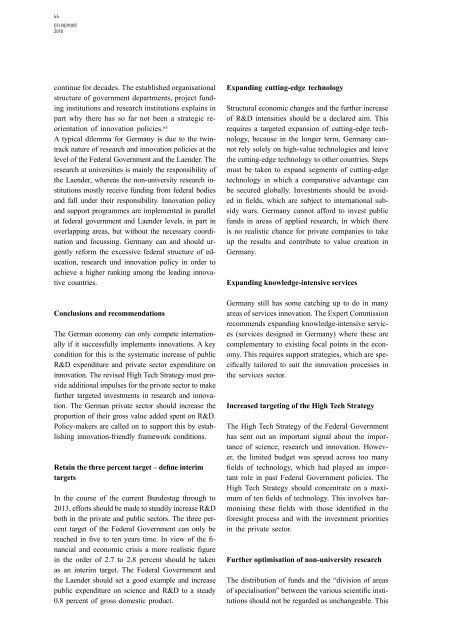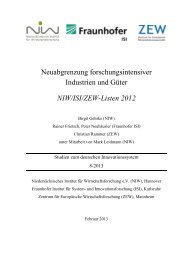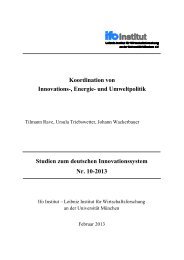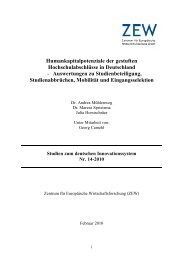research, innovation and technological performance in germany
research, innovation and technological performance in germany
research, innovation and technological performance in germany
You also want an ePaper? Increase the reach of your titles
YUMPU automatically turns print PDFs into web optimized ePapers that Google loves.
44<br />
EFI REPORT<br />
2010<br />
cont<strong>in</strong>ue for decades. The established organisational<br />
structure of government departments, project fund<strong>in</strong>g<br />
<strong>in</strong>stitutions <strong>and</strong> <strong>research</strong> <strong>in</strong>stitutions expla<strong>in</strong>s <strong>in</strong><br />
part why there has so far not been a strategic reorientation<br />
of <strong><strong>in</strong>novation</strong> policies. 65<br />
A typical dilemma for Germany is due to the tw<strong>in</strong>track<br />
nature of <strong>research</strong> <strong>and</strong> <strong><strong>in</strong>novation</strong> policies at the<br />
level of the Federal Government <strong>and</strong> the Laender. The<br />
<strong>research</strong> at universities is ma<strong>in</strong>ly the responsibility of<br />
the Laender, whereas the non-university <strong>research</strong> <strong>in</strong>stitutions<br />
mostly receive fund<strong>in</strong>g from federal bodies<br />
<strong>and</strong> fall under their responsibility. Innovation policy<br />
<strong>and</strong> support programmes are implemented <strong>in</strong> parallel<br />
at federal government <strong>and</strong> Laender levels, <strong>in</strong> part <strong>in</strong><br />
overlapp<strong>in</strong>g areas, but without the necessary coord<strong>in</strong>ation<br />
<strong>and</strong> focuss<strong>in</strong>g. Germany can <strong>and</strong> should urgently<br />
reform the excessive federal structure of education,<br />
<strong>research</strong> und <strong><strong>in</strong>novation</strong> policy <strong>in</strong> order to<br />
achieve a higher rank<strong>in</strong>g among the lead<strong>in</strong>g <strong>in</strong>novative<br />
countries.<br />
Conclusions <strong>and</strong> recommendations<br />
The German economy can only compete <strong>in</strong>ternationally<br />
if it successfully implements <strong><strong>in</strong>novation</strong>s. A key<br />
condition for this is the systematic <strong>in</strong>crease of public<br />
R&D expenditure <strong>and</strong> private sector expenditure on<br />
<strong><strong>in</strong>novation</strong>. The revised High Tech Strategy must provide<br />
additional impulses for the private sector to make<br />
further targeted <strong>in</strong>vestments <strong>in</strong> <strong>research</strong> <strong>and</strong> <strong><strong>in</strong>novation</strong>.<br />
The German private sector should <strong>in</strong>crease the<br />
proportion of their gross value added spent on R&D.<br />
Policy-makers are called on to support this by establish<strong>in</strong>g<br />
<strong><strong>in</strong>novation</strong>-friendly framework conditions.<br />
Reta<strong>in</strong> the three percent target – def<strong>in</strong>e <strong>in</strong>terim<br />
targets<br />
In the course of the current Bundestag through to<br />
2013, efforts should be made to steadily <strong>in</strong>crease R&D<br />
both <strong>in</strong> the private <strong>and</strong> public sectors. The three percent<br />
target of the Federal Government can only be<br />
reached <strong>in</strong> five to ten years time. In view of the f<strong>in</strong>ancial<br />
<strong>and</strong> economic crisis a more realistic figure<br />
<strong>in</strong> the order of 2.7 to 2.8 percent should be taken<br />
as an <strong>in</strong>terim target. The Federal Government <strong>and</strong><br />
the Laender should set a good example <strong>and</strong> <strong>in</strong>crease<br />
public expenditure on science <strong>and</strong> R&D to a steady<br />
0.8 percent of gross domestic product.<br />
Exp<strong>and</strong><strong>in</strong>g cutt<strong>in</strong>g-edge technology<br />
Structural economic changes <strong>and</strong> the further <strong>in</strong>crease<br />
of R&D <strong>in</strong>tensities should be a declared aim. This<br />
requires a targeted expansion of cutt<strong>in</strong>g-edge technology,<br />
because <strong>in</strong> the longer term, Germany cannot<br />
rely solely on high-value technologies <strong>and</strong> leave<br />
the cutt<strong>in</strong>g-edge technology to other countries. Steps<br />
must be taken to exp<strong>and</strong> segments of cutt<strong>in</strong>g-edge<br />
technology <strong>in</strong> which a comparative advantage can<br />
be secured globally. Investments should be avoided<br />
<strong>in</strong> fields, which are subject to <strong>in</strong>ternational subsidy<br />
wars. Germany cannot afford to <strong>in</strong>vest public<br />
funds <strong>in</strong> areas of applied <strong>research</strong>, <strong>in</strong> which there<br />
is no realistic chance for private companies to take<br />
up the results <strong>and</strong> contribute to value creation <strong>in</strong><br />
Germany.<br />
Exp<strong>and</strong><strong>in</strong>g knowledge-<strong>in</strong>tensive services<br />
Germany still has some catch<strong>in</strong>g up to do <strong>in</strong> many<br />
areas of services <strong><strong>in</strong>novation</strong>. The Expert Commission<br />
recommends exp<strong>and</strong><strong>in</strong>g knowledge-<strong>in</strong>tensive services<br />
(services designed <strong>in</strong> Germany) where these are<br />
complementary to exist<strong>in</strong>g focal po<strong>in</strong>ts <strong>in</strong> the economy.<br />
This requires support strategies, which are specifically<br />
tailored to suit the <strong><strong>in</strong>novation</strong> processes <strong>in</strong><br />
the services sector.<br />
Increased target<strong>in</strong>g of the High Tech Strategy<br />
The High Tech Strategy of the Federal Government<br />
has sent out an important signal about the importance<br />
of science, <strong>research</strong> und <strong><strong>in</strong>novation</strong>. However,<br />
the limited budget was spread across too many<br />
fields of technology, which had played an important<br />
role <strong>in</strong> past Federal Government policies. The<br />
High Tech Strategy should concentrate on a maximum<br />
of ten fields of technology. This <strong>in</strong>volves harmonis<strong>in</strong>g<br />
these fields with those identified <strong>in</strong> the<br />
foresight process <strong>and</strong> with the <strong>in</strong>vestment priorities<br />
<strong>in</strong> the private sector.<br />
Further optimisation of non-university <strong>research</strong><br />
The distribution of funds <strong>and</strong> the “division of areas<br />
of specialisation” between the various scientific <strong>in</strong>stitutions<br />
should not be regarded as unchangeable. This









![zur Studie [Pdf, 2.574 KB] - Expertenkommission Forschung und ...](https://img.yumpu.com/20748637/1/184x260/zur-studie-pdf-2574-kb-expertenkommission-forschung-und-.jpg?quality=85)






